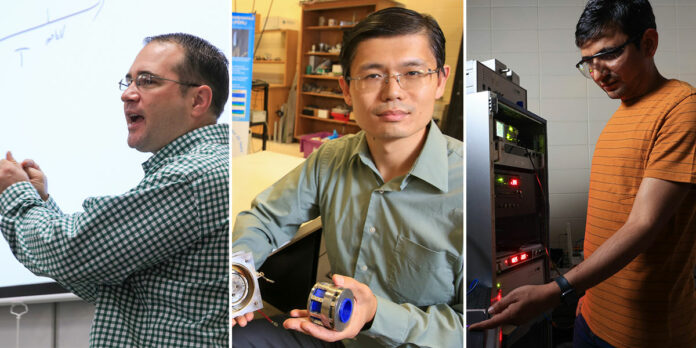HUNTSVILLE – Two researchers in the College of Engineering at The University of Alabama in Huntsville have won a grant totaling $457,963 to study a process that could ultimately lead to significant advances in space propulsion.
Dr. Gabe Xu and Dr. Jason Cassibry will research the process known as 3D magnetic reconnection. Magnetic reconnection refers to the breaking and reconnecting of oppositely directed magnetic field lines, a phenomenon at the heart of many solar events, such as solar flares, where magnetic field energy is converted to kinetic and thermal energy.
The award is part of a $9.96 million Department of Energy Funding Opportunity Announcement sponsored by the Office of Fusion Energy Sciences to support one- to three-year projects in plasma science and engineering at universities, private industry facilities and national laboratories across the nation.
“Basic and low-temperature plasma science is an important area with many scientific and technological impacts,” said Jean Paul Allain, DOE associate director of Science for Fusion Energy Sciences. “The research funded under this FOA will enable the U.S research community to address many fundamental and technological science challenges helping to ensure continued American leadership in this critical field.”
Xu, an associate professor, and Cassibry, a professor in the Department of Mechanical and Aerospace Engineering, won the award and will study 3D torsional magnetic reconnection in the laboratory through the use of plasma jets accelerated along open magnetic field lines.
Magnetic reconnection is a fundamental process where magnetic energy is converted into heat, kinetic energy and fast particle energy. The magnetic reconnection thruster concept can, in theory, generate exhausts with velocities of hundreds of kilometers per second, well beyond the capability of existing thrusters.
“Being a propulsion person, the fact that magnetic reconnection could be the next step in space propulsion got me interested in this research,” said Xu. “Studying the fundamental physics and behaviors of 3D TMR, and in particular how energy is transferred from the magnetic field to the plasma in order to accelerate the plasma jet, is important. The energy conversion to produce high velocity plasma jets has applications to space propulsion.”
The UAH researchers will collaborate with SpaceWave LLC to develop a TMR experiment consisting of a coaxial plasma gun and an external null field coil at UAH. The project will run through July 2026.
“This research will advance basic plasma science and engineering by demonstrating a first major experiment to study 3D TMR in the laboratory,” Xu said. “To generate 3D TMR requires two sets of magnetic fields. We need a high-current plasma jet to generate a strong azimuthal magnetic field, which is where the plasma gun comes in. The plasma gun, which kind of looks like a railgun, can generate a plasma jet with high currents and azimuthal magnetic field.
“The experimental effort will be supported by computational modeling. Magnetic reconnection can produce extremely high-velocity plasmas, which would translate into high-efficiency propulsion.”
Don’t miss out! Subscribe to our email newsletter to have all our smart stories delivered to your inbox.



